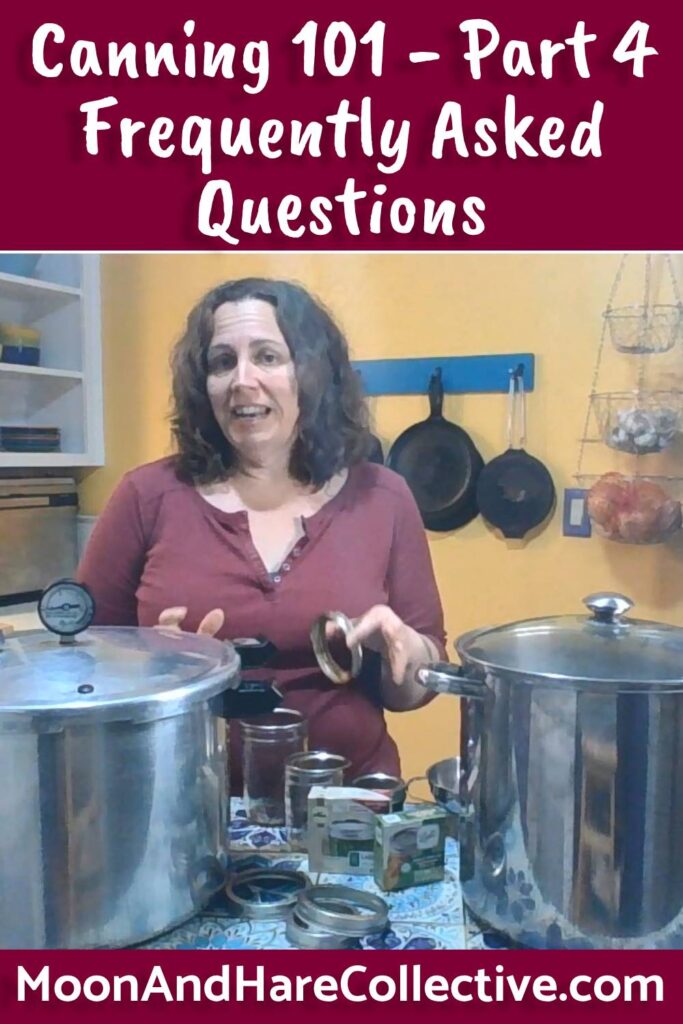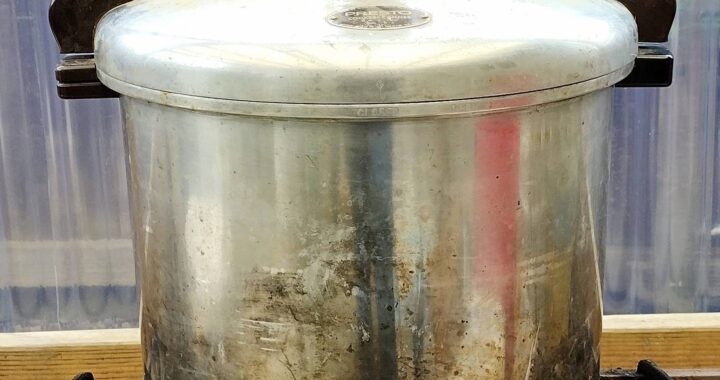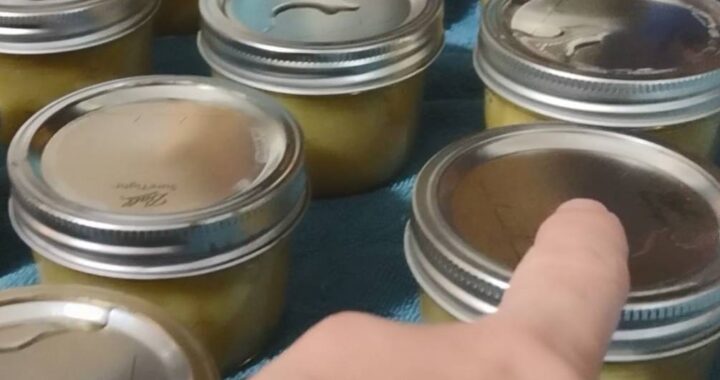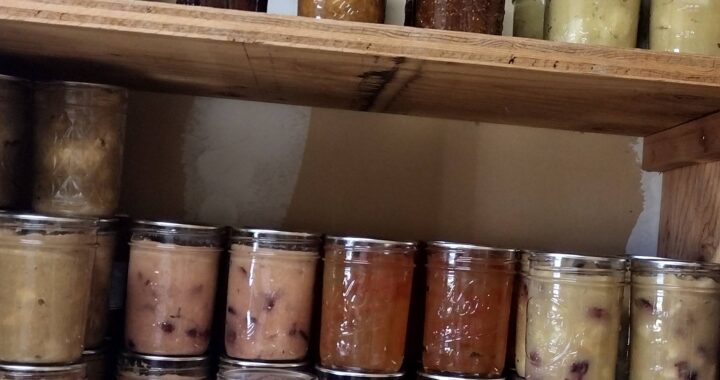And thusly, we reach the end of my treatise on canning. I hope that these videos have been helpful and inspire you to get started with some canning for your family. This final video answers many of your questions about the procedures and processes involved in canning, and how important they are. If you have any other questions, please message me and I’ll answer them and add them below!
Don’t forget to check out Part 1: The Science and History of Canning, Part 2: Waterbath Canning and Part 3: Pressure Canning


Transcript:
Hey y’all! It’s me, Chrissy, back again with the last section of my 4 part video series on canning basics. In this video, I will go over some common and less common frequently asked questions you might have about waterbath and pressure canning.
You might have heard this a few times if you’ve been following along – but I’m Chrissy Bernards, the owner of Moon and Hare Collective and Urban Farm here in Oregon. I am an urban agriculture and homesteading educator, a curriculum developer, and a community herbalist.
I grew up on a vegetable farm, where I learned how to can and preserve food, and eat seasonally, along with sewing and other DIY skills. I ran away from the farming lifestyle as soon as I could, but after a bunch of years, I felt the pull back to growing food and traditional homemaking. I now use permaculture and regenerative agriculture techniques on my urban homestead, where I teach about urban farming, food preservation, cooking on a budget, seasonal living, and other homesteading skills as a medium to introduce people to food systems and sustainability issues.
I’m really interested in the science and history behind the methods that we use to preserve food, so I’m able to understand the safety and reliability of the process. Then I know which rules I can bend or break!
OK! Make sure you subscribe to my newsletter at the link in the description so you’ll get notified when I put out more videos with valuable homesteading and homemaking information!
Let’s get to the questions!
I’ve tried to organize these in order of the canning process, we’ll see if I succeed. If you have a question that I haven’t answered here, please send me an email and I’ll try to answer it for you!
Can fruit be canned without sugar?
Yes. If the fruit is high enough acid, it can be waterbath canned without sugar. I’m talking about fruits like peach and pear halves. However, I have found that a light sugar syrup is needed to keep the texture and the flavor of the fruit. It’s like the flavor just dissipates into the liquid without any sugar.
The exception to this in my experience is applesauce and pear sauce. They have an amazing amount of flavor and are high acid enough that they don’t need any sugar at all, so I never can them with sugar.
Do jars need to be sterilized before canning?
No, you don’t. They do need to be clean, of course, but they will be sterilized in the waterbath or pressure canner, as long as the jars are in for at least 5 minutes
What determines how long a food is waterbath or pressure canned for?
The Density, the porosity, and the acidity of the food
In the case of acidity, sometimes a food is so acidic and heated through long enough that no microorganisms can grow in it. The canning process is actually for sanitizing the jar! This is the case for jams, mostly. That’s why they’re just waterbathed for 5 minutes.
But some foods, like dry beans or meat are very dense and low acid, so they are pressure canned for a very long time to make sure the proper temperature is reached all the way to the center.
Some foods cannot be canned at all. Pumpkin puree and mashed potatoes are low acid, and so dense that they cannot be heated all the way to the center. Pumpkin, winter squash, and potatoes are best canned in cubes – which you can then mash up for puree or mashed potatoes.
Do I really need to leave a certain amount of headspace in the jar?
Yes, leaving the specified amount of headspace in a jar is important to make sure a vacuum seal is created. We leave headspace because food expands when it’s heated, so we want to make sure there’s enough space for that without the jars overfilling. If too little headspace is allowed the food may expand and bubble out when air is being forced out from under the lid during processing. The bubbling food can leave a deposit on the rim of the jar or the seal of the lid and prevent the jar from sealing properly. If too much headspace is allowed, the food at the top is likely to discolor and the jar may not seal because the air won’t be fully pushed out of the jar.
The amount that foods expand has to do with the air content of the food. For example, Jams and jellies are already very hot when they’re put in the jar, so they only need about ¼ inch headspace, whereas low acid and cold-packed foods need 1- 1 ½ inches of headspace.
What’s the difference between cold-packed and hot-packed?
This is just how the food is going into the jars – it’s hot – which means hot packed, or it’s cold- which is cold-packed. When you’re hot packing jars, the jars will heat up, so you can put them into a hot canner. If you’re cold-packing and not pouring a hot brine over the food – like in the case of dried beans or meat, you’ll want to make sure the water in the canner is no hotter than lukewarm.
What does finger-tip tight mean?
Finger-tip tight is how tight they say to screw on the band. Personally, I don’t understand how this is descriptive. Basically, screw the ring on just until it meets some resistance. Don’t overthink it.
Do you ever break jars when canning?
It does happen sometimes! It’s always a bummer because you lose a jar and the food you’ve worked so hard to process. In my experience, it’s almost always an old jar, but occasionally it happens because the contents and the jar weren’t heated beforehand. Cold glass going into a boiling water bath is not a great situation.
You can’t really do much about old jars, except not use them if you choose. But do always inspect jars for hairline cracks. For the cold jar problem, make sure to always make sure your jars are heated up before putting them in the waterbath.
If you’re putting hot liquid into the jar, like in the case of jams or a brine, just let the jar sit a minute before putting it in the canner. You can also heat up your jars in the dishwasher beforehand, which has the double purpose of making sure they’re nice and clean.
What do you do when it happens?
If you hear the jar pop in the middle of canning, don’t do anything. Just wait until the process is done. No sense in starting the rest of the jars all over.
When it’s all done, remove the rest of the jars to a towel. Now, carefully remove the broken jar and the contents and discard. Usually the bottom has just popped off the jar, so it’s fairly easy to remove. Still, you probably want to dump the canner out over a sieve or strainer to catch everything.
Wash out the pot and use fresh water for any more canning that you’ll do.
What do you do if a jar doesn’t seal?
I actually just had this happen – because I didn’t get the ring on the threads of the jar properly. It was a bummer because it was pickles, and they really need a month to brine before they’re really tasty.
If the jar that didn’t seal had a food like a sauce – even applesauce, ketchup, BBQ sauce, tomato sauce, broth, or jam or jelly – I’ll run it through the canner again. With these foods, it won’t really change their texture
However, if it’s something that was raw packed, like pickles, or fruit, – or meat or beans- putting them through the canner again may turn them to mush. So it’s better to refrigerate them and use them within about a week or so. Basically anything that you want the texture to last as long as possible, those I wouldn’t reprocess.
What are some reasons for jars not sealing?
Sometimes, despite our best efforts, a jar doesn’t seal. Like I mentioned a second ago, this just happened to me when I canned pickles. I didn’t pay attention when I put the ring on, and the threads didn’t match up.
It can also happen if the rubber on the lid doesn’t seal to the jar. This rubber ring here is how the lid seals to the jar. It needs to be softened before being placed on the jar. It used to be recommended that we boil the lids, but lids these days don’t require it. I still soak my lids in a little warm water to make sure that the rubber gets soft to make a seal.
Occasionally the rim of a jar can get a nick in it, which will cause it to not seal – before filling the jars, or at least when you’re wiping down the rims, make sure to check for nicks and cracks.
Another reason jars might not seal is too much headspace – I talked about headspace a little earlier. If there is too much headspace, the jar may not seal. Just because sometimes they do seal, doesn’t mean it always will. It’s best to follow guidelines about headspace.
Then there’s Siphoning – if you didn’t leave enough headspace, sometimes you can get siphoning – meaning the liquid was sucked out of the jar. This can cause there to be too much headspace, which is a reason jars may not seal, but also if the liquid is chunky or oily, it can get on the rim of the jar while siphoning and not let it seal.
Faulty lids – there are lids that are better quality than others. And people definitely have their preferences. Just be careful to check reviews when buying lids.
Do you keep the rings on the jars in storage?
No. The rings aren’t meant to be left on the jars while they’re in storage. The reason for this is that often, if they do have microorganisms growing inside, there may be gas build up and the lid might unseal. This is a really good way to know if the product has gone bad.
If you’re giving your canned goods as gifts, you may want to include the ring in case the recipient doesn’t have rings for once it’s opened, however.
How do you know if a jar has gone bad?
If you follow the latest canning guidelines closely you shouldn’t have to worry much about the quality or safety of your home-canned food. But just like with store-bought food, it’s always smart to check before using it. When you pull a jar off the shelf, make sure the seal is still intact and nothing looks off. If the jar isn’t sealed, that means the food has spoiled. Don’t use food from jars that are no longer sealed. Spoilage causes gasses that can break the seal or make the lid puff up. Also, if the lid comes off easily without needing to break the seal, don’t eat the food. Other signs of spoilage include mold, bubbling, cloudy liquid, spurting when opened, leaks,, fermenting, a slimy texture, or bad smells. Also, if you know that low-acid foods were canned improperly (like using a water bath instead of a pressure canner), don’t eat them. If you think the food is spoiled, throw it away without tasting it, and make sure people and animals can’t get to it.
How long will canned food keep?
Most official canning sites will tell you that canned foods will stay good for a year to 18 months. I’ve had canned foods last a lot longer than that. If the seal is still good, then the food is safe, so it’s really just a question of whether the food inside is still palatable. It’ll get mushier and may lose its flavor the longer it’s stored. Ideally, you’re canning enough for one year, and replacing it the next door, so hopefully it’s not a big deal and you’re moving through the preserved foods over the year.
Ok, I think that’s about it. I think there are a lot more questions that could be answered, so please email me if you have any more and I’ll answer them and post it on the website as well.
Thanks for joining me for this adventure to learn all about canning. What a great way to preserve all the delicious food from your garden, or the farmer’s market, or wherever you get a great deal on bulk food!
Don’t forget to subscribe to my newsletter so you’ll get access to all the freshest content!



